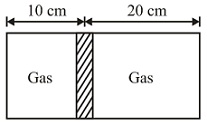Q.
The diagram shows a horizontal cylindrical container of length $30 \, cm$ , which is partitioned by a tight-fitting separator. The separator is diathermic but conducts heat very slowly. Initially, the separator is in the state shown in the diagram. The temperature of the left part of the cylinder is $100 \, K$ and that on the right part is $400 \, K$ . Initially the separator is in equilibrium. As heat is conducted from the right to left part, separator displaces to the right. Find the displacement of separator (in $cm$ ) after a long when gases on the two parts of the cylinder are in thermal equilibrium.

NTA AbhyasNTA Abhyas 2020Thermodynamics
Solution: